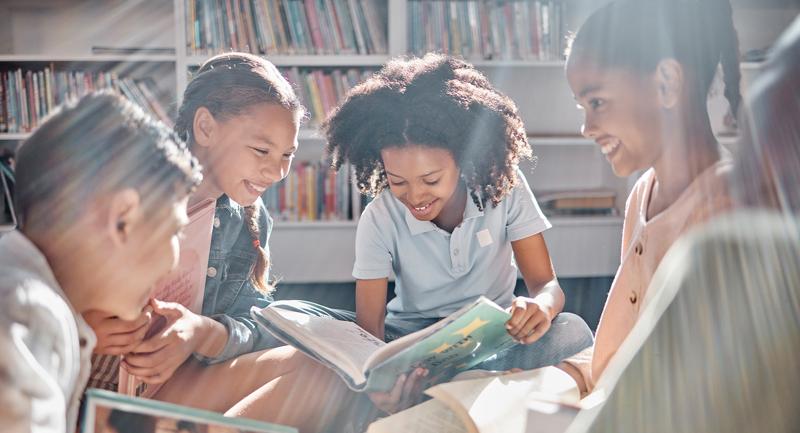Imagine a new 2nd grade teacher, eager to read aloud and discuss a book she has found. She knows from literacy research that rich discussions during read alouds support comprehension, language development, and deep learning. She chooses a few places to stop and discuss compelling or complex parts, planning open-ended questions to check for understanding and engage children in conversation. Somehow, her plan falls flat. When she asks questions, only a few children respond with one-word answers. The ideas and dialogue the teacher hoped her questions would promote do not happen. She wonders what went wrong.
Having rich discussions with children during read alouds is a challenge that Children's Literacy Initiative, a nonprofit that collaborates with districts to support early literacy instruction, is all too familiar with. Our coaches work with teachers in the K–5 grades who know the value of purposeful talk in their read alouds but are unsure of how to improve. These teachers have usually tried the most obvious techniques for promoting student interaction: choosing engaging books, adding turn and talk opportunities, or asking open-ended questions that promote comprehension. Though these teacher moves can help, the strategies most needed to raise the level of teacher-student interaction in read alouds are both simpler and more elusive than teachers might think.
Focusing on Responsiveness
Responsiveness, or a teacher's ability to flexibly shift and modulate questions and scaffolding in relation to children's language and responses, makes a world of difference. Examples of responsiveness include replying to a child's initial thinking with interest and enthusiasm, probing them to elaborate, waiting after a question to give a child time to respond, echoing and extending a child's initial fragmentary answer to encourage them to say more, or drawing an explicit connection between two children's responses.
Being responsive to children's ideas, thoughts, and comments builds joint understanding and moves beyond simple forms of questioning, where there may be little real dialogue between children and one idea may not be connected to another. When we pay attention to children's contributions during read alouds, "the talk can move away from an initiation-response-evaluation sequence toward true discussion and joint construction of meaning" (Price et al., 2016). When discussing Double Bass Blues, a picture book about a resourceful young musician named Nic who crosses the city alone with a huge double bass, a teacher might respond to one child's observation about Nic being afraid with the following: "That is such an interesting observation. Tell me more about why you think Nic is afraid."
The teacher could then connect that child's response to another child's observation about the fierce dog chasing Nic: "I wonder if what KC just added about the dog helps to give us a bigger picture of Nic's fear. What do you think?" In doing so, the teacher deepens everyone's understanding of both Nic's feelings and the reason for his feelings.
Conversations in Action
We developed two practices—responsive questioning and responsive scaffolding—to help discussion feel like a natural, back-and-forth conversation between friends. Teachers honor and affirm children's thinking by replying to their contributions with interest and then facilitate new conversation intended to extend children's thinking about the text.
Responsive Questioning
Based on questioning techniques developed by Isabelle Beck and Margaret G. McKeown, responsive questioning combines initial open questions with follow-up questions that build on children's first tentative responses. Open questions call on children to describe and explain ideas in a text rather than simply recalling or retrieving words from the text. Open questions usually begin with "why" or "how" as opposed to "what," inviting more than one answer, interpretation, or thought: "Why did the girl want to climb the tree?" "How did they build the boat?"
Follow-up questions are usually necessary to get children to respond well to initial open questions. Helping children to make meaning from what they read "requires teachers to take cues from a student's initial response, which with young children is often very limited, and precede from there" (Beck and McKeown, 2001). Follow-up questions enable children to transform their initial sparse responses to open questions into elaborated constructed responses, which build language and comprehension.
These questions can take many forms. A teacher may repeat and rephrase what a child says in their initial response, and then ask the child to elaborate on what they have said or connect it to other children's observations: "You and Lupe just explained how the giant got lost in the mountains. How do you think the giant was feeling when that happened?" Or a teacher may incorporate a child's response into her own subsequent questions as a way to extend the child's initial idea with the whole group. Most importantly, follow-up questions usually contain thoughtful generic probes, such as "why" or "how," that ask children in a conversational manner what something in the text means or is about.
Responsive Scaffolding
Based on scaffolding techniques described by Lisa Hammett Price and Barbara A. Bradley, responsive scaffolding entails differentiating support during a read aloud discussion. The teacher's aim is for the children themselves to do as much of the idea generation and question initiating as possible. Responsive scaffolding uses three levels identified by Price and Bradley—high support, low support, and raise-the-bar support—based on the type of responses they hear from children during the discussion.
High-support strategies are for the moments when children's responses are incoherent or when they appear not to have the language to express what they are trying to say. If a teacher asked, "How did the rabbits find food?" and a child responded with, "They eat," the teacher could ask supportive close-ended questions to help the child further explain their thinking: "Did they go to the garden to eat?" "What did they eat in the garden?" Other techniques include asking children to fill in the blank ("The rabbits ate _____?") or to ask children to point, gesture, or pantomime to convey their thoughts.
Low-support strategies are for inaccurate or ambiguous content. If a teacher asked, "Why did the dog run away?" and a child answered, "Its ball," then the teacher could ask the child to tell them more until, with encouragement, the child is able to explain that the dog ran away because it left its ball at the park and wanted to retrieve it. Other techniques include pointing to an illustration to give a child more information or rephrasing children's words while checking for accuracy ("Do you mean...?").
Raise-the-bar scaffolding strategies are for when the teacher wants to further deepen the thinking in coherent responses. If a teacher asks, "What was the cat doing?" and a child answered, "Looking in the window," then the teacher could ask the child to infer why—to think and talk more about what piqued the cat's curiosity. Other techniques include explaining ideas or point of views and comparing and contrasting information.
Ideally, a teacher uses all three of these levels of scaffolding throughout a read aloud. With the lightest scaffolding possible, the discussion becomes a rich tapestry of the children's ideas and thoughts, woven together by the teacher and made vibrant by the thread of each child's contribution.
Responsive scaffolding works together with responsive questioning when used in sequence. In a sense, follow-up questions are in and of themselves a form of responsive scaffolding, yet it is also helpful to think of responsive scaffolding as the next step if questions yield no or minimal responses. This reminds us that differentiation and gentle, persistent querying are often necessary to initiate and sustain high-quality group discussions with young children.
Compelling Picture Books for Rich Discussions
To foster deep discussions, books themselves matter, too. Although it is possible to discuss almost any picture book with the right approach, it often requires a compelling book with significant depth and ideas to have a rich discussion. Fiction picture books that best promote deep discussions are ones with absorbing illustrations, compelling language, complex plots, and characters who experience challenges and successes. Fictional stories that are open-ended or leave gaps for the reader to fill in, such as pages with no text, can also be great for inspiring conversation. Matt de la Pena's picture book, The Last Stop on Market Street, in which a boy and his grandmother travel across the city on a bus, offers young listeners so much more to discuss than many other picture books based on children going places with family. It includes character development, suspense, and moving depictions of an intergenerational relationship.
The nonfiction picture books that work best for deep discussions are ones that engage readers with true stories or offer children a new understanding of events, people, or concepts that already seem familiar to them. In The Undefeated, the winner of the 2020 Caldecott medal, Kwame Alexander's poem and Kadir Nelson's illustrations pay tribute to Black history in ways that may open up engagement for older students more than prosaic presentations of the past.
Choose nonfiction that might shift or expand a child's perspective to include new ways of looking at the world. For informational texts, look for books that engage readers by presenting information clearly and creatively. Draw students into conversations around the arrangement of information on the page, the quality of the photographs or illustrations, and how the author researched the book. Look for stories in which people solve problems in unusual or unexpected ways. Understanding what the children care about can also determine book choices. A book related to an experience everyone in the classroom had together—seeing the season's first snowfall, finding a spider web, or solving a problem—can connect students to text and to each other.
Read Alouds and Discussion Now
Working to consciously build rich discussion into read alouds in person or virtually matters now more than ever in a time of national standards and large-scale curriculum implementation. Many teachers base their read aloud discussions on the questions in a published curriculum or on their need to teach specific standards. Prioritizing scripts during read alouds can lead to stilted discussions if children are at a loss for how to answer the questions. Likewise, in a synchronous distance read aloud, children can struggle to answer initial questions about a book without apt follow-up questions. In these situations, a teacher's understanding of responsive questioning and responsive scaffolding can save the conversation from falling flat.
Young children are likely also unsure of how to participate in live or virtual group conversations, but eager to do so. With the support of responsive questioning and responsive scaffolding, we can ensure that children will be able to contribute meaningfully to read aloud discussions wherever they are.







